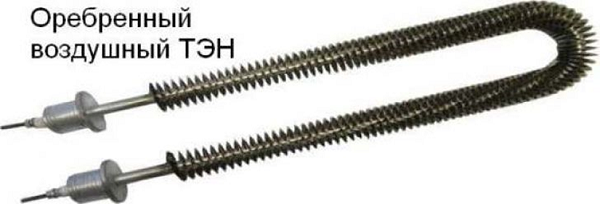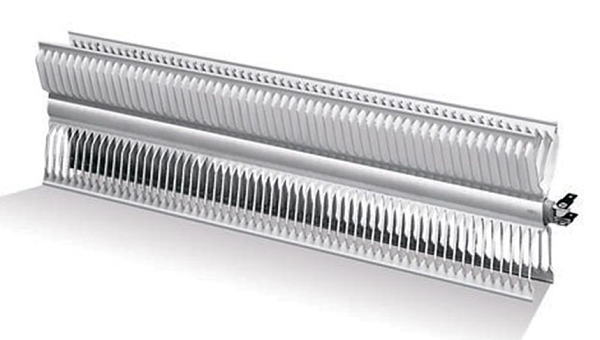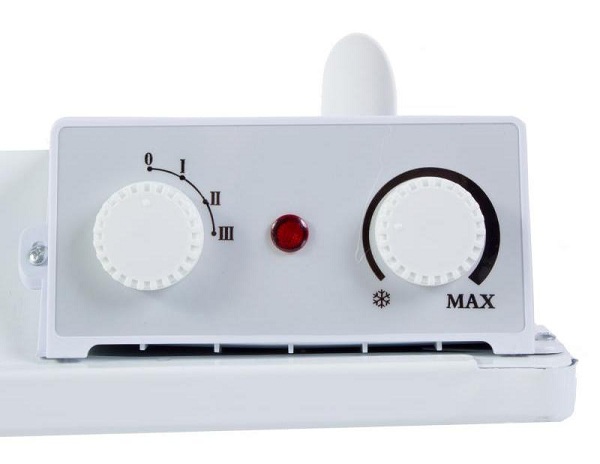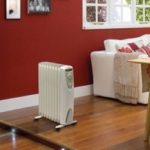How does electric convector work
For heating residential and non-residential premises used a lot of different types of heaters. But the most simple, effective and not difficult to install options are electric convectors. The principle of their work based on convection - the natural movement of air masses (heated air rises, cools and falls down).
Content
How does the convector
The device of the convector is quite simple. The general scheme of the device is shown in the figure below. Consider the main details in more detail.

A heating element
In electric heaters of convective type, heaters of 3 types are installed.
- Needle consist of a body on which loops of nichrome (an alloy of nickel and chromium) in the form of needles are mounted. The loops are located on both sides and tend to quickly warm up and cool. Due to this, it is convenient to regulate the required temperature in the room. Another advantage of the needle heater units is their low price. But these heaters have drawbacks: the needle elements cannot be used in rooms with high humidity, and they can burn through oxygen and also dry the air.

- TEN (tubular electric heater) It is a hollow tube with a nichrome spiral located in it. The area between the body and the spiral is filled with a dielectric. For better heat transfer on the body of the heater install ribs. The advantage of TEN is that its case is hermetically sealed, so devices with such a heater can be used in damp rooms. The disadvantages of the heater can be called: low efficiency, a long warm-up time to enter the operating mode, working heaters emit a slight crackle.

- Monolithic consist of a ribbed body with a thread of nichrome soldered into it.Such heaters have maximum heat transfer, are silent, all parts of the case are heated uniformly. Devices with monolithic heaters are the most expensive in comparison with the above, and are considered the best. Read more about the features of each type in the article.types of heating elements in convectors.

Control unit or thermostat
The heating unit is controlled by mechanical or electronic thermostat:
-
- Cheaper model units have mechanical thermostatwhich, when a certain temperature of the heater is reached, breaks the electrical circuit. When the machine cools down, the circuit closes again and the heater continues. The disadvantage is that with such a regulator it is impossible to maintain the desired temperature in the room, since the thermostat is triggered by heating the bimetallic plate, and the air temperature is not taken into account.

- At electronic control several sensors interact. The principle of their operation is to monitor the heating of the unit itself, as well as the ambient temperature. After data processing by the microprocessor, the work of the heater is corrected.Modes of operation can be set from the panel located on the case, or from the remote control (if provided). There are models of devices with programmable modules. With their help, you can install a room heating program for the week. This is convenient, for example, if on weekdays from 8:00 to 17:00 there is no one at home. Therefore, the device is set to maintain the temperature, and by the arrival of the household, the device turns on at full capacity and quickly warms the room to the desired values.

- Cheaper model units have mechanical thermostatwhich, when a certain temperature of the heater is reached, breaks the electrical circuit. When the machine cools down, the circuit closes again and the heater continues. The disadvantage is that with such a regulator it is impossible to maintain the desired temperature in the room, since the thermostat is triggered by heating the bimetallic plate, and the air temperature is not taken into account.
From above the device is closed by the case with openings for an air intake. They are located at the bottom and at the top.
The principle of operation of the electric convector
So how does a convector work? The principle of operation of any kind of convector, gas or electric, based on the use of the properties of air when heated to rise, and when cooled down. Since the device is built a heating element, then when it is heated, the air begins to circulate, passing through the device from the bottom up. The heated air rises to the ceiling, gives thermal energy to the room, cools and goes down. Thus, there is a circulation of air masses in the room.
When reaching a certain temperature in the room is triggered thermostat or temperature sensor (depends on the type of control - mechanical or electronic), which disable the heater. After some time, after cooling the contact plate (in the case of mechanical control), the contacts close, and the heating continues. With the electronic control module, the temperature sensor will work and turn on the unit only when the air temperature in the room reaches the values lower than those that have been programmed.
Heaters also have differences in installation method. They are wall mounted, inline, baseboards, outdoor.

Calculation of the power of the electric heater
There are two ways to calculate the power of the device.
By area
It should be borne in mind that the calculation of the capacity of the heating unit by area gives approximate figures and requires amendments. But it is simple and can be used for a quick, rough calculation. So, on the basis of the established norms, for a room with one door, one window and a wall height of 2.5 meters, a power of 0.1 kW / h per 1 m is required.2 square
For example, if you take to calculate a room with an area of 10 m2then the required power of the unit will be 10 * 0.1 = 1 kW. But it is worth considering some factors. When corner roomThe correction factor will be 1.1. This number should be multiplied by the found result. Provided that the room has good thermal insulation, plastic windows are installed in it (energy saving), then the result of the calculation should be multiplied by 0.8.
By volume
To calculate the heating convector power by volume, it is required:
-
-
- calculate the volume of the room (width * length * height);
- The number found must be multiplied by 0.04 (exactly 0.04 kW of heat is needed in order to warm up 1 m3 premises);
- applying the coefficients, to refine the result.
-
Due to the fact that the height of the room is used in the calculation, the power calculation will be more accurate. For example, if the room volume is 30 m3 (area 10 m2, ceiling height 3 m), then 30 * 0.04 = 1.2 kW. It turns out that for this room you need a heater with approximately the power slightly higher than that found.
For a more accurate result, power should be calculated, using the coefficient. If there is more than one window in the room, then for each of the following, 10% is added to the result.This indicator can be reduced if there is a good thermal insulation of the walls (floor in a private house).
As an additional source of heating
If the main heating in severe frosts is not enough, then often an electric convector is used as an additional source of thermal energy. The calculation, in this case, is as follows:
-
-
- when calculating the indicator by area, 30-50 W is required for each square meter;
- in terms of volume, per 1 m3 0.015-0.02 kW is required.
-
Advantages and disadvantages of electric convectors
Positive points:
- Easy installation and use. It is enough to hang on the wall or install on the legs, connect the cord to the outlet, and the device is ready for operation.
- Service life is designed for a period of more than 15 years. Maintenance of the unit does not require, except for periodic removal of dust.
- The cost of the device is relatively low.
- Human control is not required to maintain the required temperature. All this will make automation and electronics.
- No noise. Unless mechanically controlled heaters can emit a low click when the thermostat is turned on and off. Devices with electronic module work silently.
- Electric convector has a simple principle of operation.
- The efficiency of heaters can reach 95%.
Negative points:
- significant electricity consumption;
- heating large areas using only electric convectors is inefficient, in large rooms they can only be used as additional heating;
- Devices with open (needle-like) heating elements can produce an unpleasant smell when turned on from combustible dust that has settled on the heater.
It should be remembered that electric heating units is a technique that does not tolerate violation of safety rules. Do not cover the appliance or dry laundry on it. The device will overheat, and, at best, protection will work.
The socket must be located on the side of the unit (prohibited from above) at a distance of at least 100 mm from the case.
Only with proper operation of the convector can a comfortable and cozy atmosphere in the house be guaranteed.

/rating_off.png)












